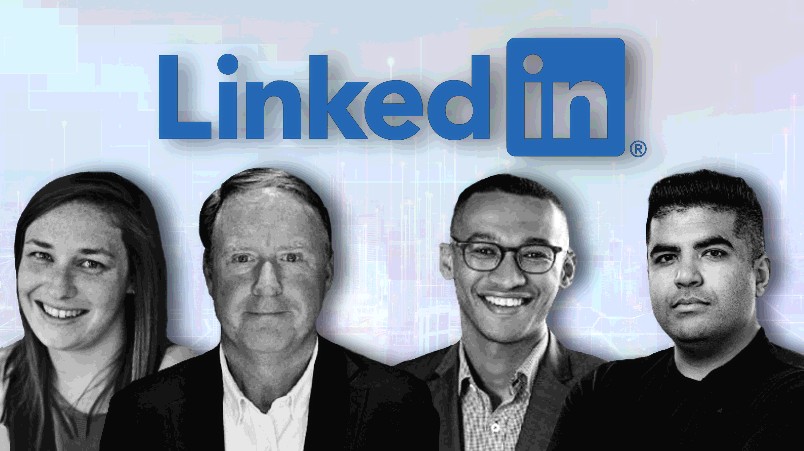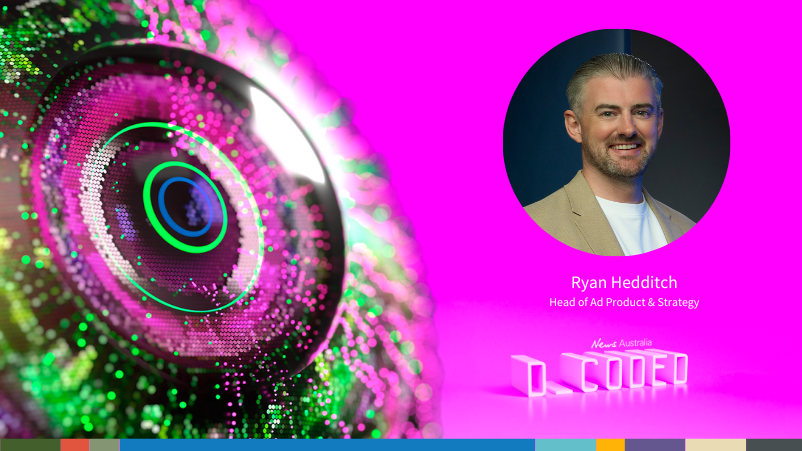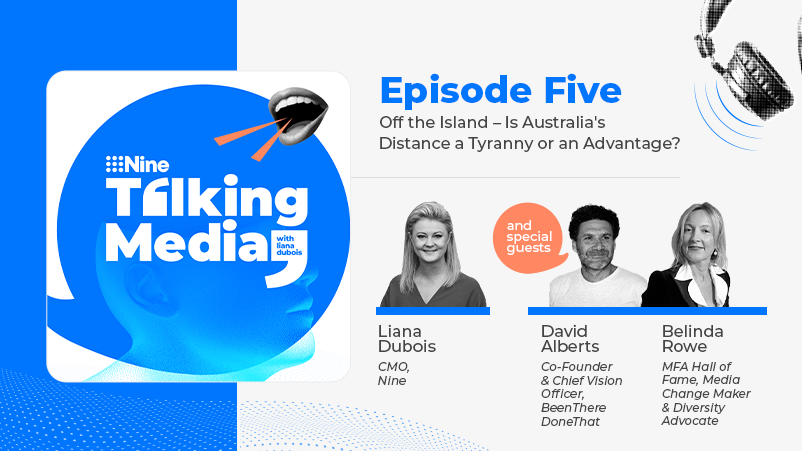Once burned by partners who abused its trust – and data – LinkedIn is rebuilding martech-adtech bridges; CDP and CTV initiatives incoming, marketers keen, agencies want more

Claire Bertolus, Penry Price, Samir Mane and Adnan Khan.
A decade ago LinkedIn made some questionable martech and adtech partner choices, subsequently accused by a key exec of abusing their status – and its data. Burnt, the now $14bn business chose to go-it-alone. But tech hermit status ended in 2019 when a Microsoft-Marketo deal started to drive solid cost of conversion savings for customers like law firm Gilbert and Tobin. In recent weeks, the platform has inked a deal with Hubspot and Mi3 has learned LinkedIn is now working with Tealium on a much-requested conversion API. Meanwhile, the company is putting flesh on the bones of a CTV initiative for B2B advertisers. But marketers and agencies want more, Google and Facebook-style more.
What you need to know
- After a decade of doing its own thing - after being burned by partners that abused its trust - LinkedIn is now re-engaging with the CRM and adtech providers.
- The first hints came in 2019 when it did a deal with Adobe – and its parent company Microsoft – but much of the initial focus for integration was in Microsoft's own Dynamics platform. A deal with Hubspot announced two weeks ago is a marker that partnerships are back on the table.
- Marketers say they are already achieving gains from the integration with Adobe's Marketo: Gilbert and Tobin has cut cost of conversions by 15 to 20 per cent.
- Mi3 has also learned LinkedIn is working on an important connector into leading enterprise CDP platform Tealium, and there's more detail emerging about the business platform's CTV advertising initiatives.
- But marketers are harsh markers. They says Meta and Alphabet are the yardsticks – and the Microsoft-owned platform has miles of ground to make up.
We were very concerned about the access, and the privacy and security needs of the member data. We saw examples of partners we did integrations with 10 to 12 years ago who were abusing the partnership, and the data, by the way they behaved. We then clamped down and went for much more of a platform-only approach versus really embracing the external ecosystem.
If you want to go fast, go alone, if you want to go far, go together. B2B marketers want LinkedIn to go far because they understand the more it connects to the wider technology ecosystem, the greater the benefits to them.
Take Gilbert and Tobin. By utilising the integrations between Marketo and LinkedIn, the law firm claims big reductions in the cost of conversion. It’s a result that demonstrates the opportunity for B2B brands as LinkedIn starts investing in the kind of robust ecosystem partnerships it has traditionally shunned.
Samir Mane, marketing technology manager at Gilbert and Tobin told Mi3 the firm uses the integrations between LinkedIn and its martech and CRM stack to help create audiences for more effective advertising.
“From a marketing perspective, it drops our cost per conversion by 15 to 20 percent compared to doing it the traditional way, creating your audience, based on what you already know, in your system," per Mane.
“If you have created a list in Marketo you can send that list down to LinkedIn to create lookalike audiences. We’ve seen really, really good results because it's become super targeted, especially if you're looking for people in specific industries such as banking," he added.
“We've seen some we've seen big success in doing so because [of the quality] of the data that we're getting there, the MQLs (marketing qualified leads) are quite high. They're who we want to be speaking to on a regular basis. The only drawback that we've seen is that when we're seeing them come back into our system, they come back with a different email address.”
But Mane believes LinkedIn may already be fixing this. “They recently released their verifiable feature; you can verify your identity with your LinkedIn account.”
The law firm is reaping the benefit of a deal struck between LinkedIn, Microsoft, and Adobe in 2019.
While LinkedIn’s initial focus was in building deeper connections with owner Microsoft’s own Dynamics product, Adobe was an early beneficiary of a desire to extend into the wider martech world.
In 2019 Adobe inked an expanded partnership with Microsoft and a fresh integration with LinkedIn aiming to turbocharge account-based experiences. The parties say they aligned key data sources to enrich account-based profiles in Adobe Experience Cloud, incorporating Marketo Engage and Microsoft Dynamics 365 for Sales. The collaboration was designed to help B2B marketers and sellers to more effectively identify, understand, and engage B2B customer buying teams.
Jump forward to 2023 and Hubspot recently made its new integrations with LinkedIn a feature of its recent Inbound conference in Boston.
According to a Hubspot spokesperson, the new relationship with LinkedIn should make the process of how its clients prospect, build relationships, and close deals more efficient by syncing HubSpot’s Smart CRM with LinkedIn Sales Navigator.
A private beta is just kicking off.
According to Michael Walton, VP of Product, Sales Hub, at HubSpot, “With buyer behavior evolving quickly, the old playbook of adding more headcount, more activities, and more point solutions to drive sales no longer delivers.”
They [LinkedIn] have never had a conversion API (CAPI) and it's been a huge gap in their ad tech suite. They have always had the insights tag, and they've always had the ability to track conversions and get some intelligence on firmographic or industry demographics from pixels. But they haven't addressed cookie deprecation or intelligent tracking prevention.
Happy CAPI
Mi3 has also learned that CDP provider Tealium, whose Australian client roster includes NAB, Woolworths and Lion, is testing a conversion API with LinkedIn. This is one of the top requests from Tealium users, according to Adnan Khan, co-founder of Auckland-based data and marketing consultancy Stitch. It's further evidence that LinkedIn is finally taking the ecosystem seriously.
It has been a long time coming.
Penry Price, vice president of marketing solutions at LinkedIn, acknowledges that the approach to the martech ecosystem is evolving.
According to Penry, in the ten years he has been at LinkedIn the company has gradually started to better understand and embrace a channel strategy.
He attributes any caution to some early missteps.
“We were very concerned about the access, and the privacy and security needs of the member data. We saw examples of partners we did integrations with 10 to 12 years ago who were abusing the partnership and the data by the way they behaved. We then clamped down and went for much more of a platform-only approach versus really embracing the external ecosystem.”
While LinkedIn hasn’t yet done a full 180-degree turn, he says the company wants to be easier to work with – whether that’s clients, publishers, or agencies (the latter of whom LinkedIn has already developed APIs for).
“We are getting to a place of maturity where we are doing a lot more with the external facing ecosystem, [and] embracing those kinds of business.”
The shift is a recognition that the way buyers and sellers interact has evolved post-pandemic and that LinkedIn's bread and butter lies in greasing the wheels of B2B commercial relationships.
“We know it takes a long time, there's a long buyer cycle, sometimes many months until there’s a purchase made. There are many influencers involved. There are many decision-makers involved. Those are the realities that B2B sellers work with. We want to remove friction by working with companies where buyers meet and discuss.”
Gimme more
According to Stitch’s Khan, whose company works with brands such as Tourism NZ, Turners Cars, and Skills Consulting Group, LinkedIn has made good progress with integrations into the CRM world: “Recently they've done some really good integration with Sales Navigator and Microsoft Dynamics.”
But he reckons the platform still lags when it comes to integrating with adtech, with LinkedIn is probably the only billion-plus-user ad platform that still doesn’t have a conversion API.
However, it appears LinkedIn recognises that failing – and is mobilising.
A conversion API in a martech platform such as Tealium’s CDP helps bridge the gap between online advertising and customer data management. It essentially serves as a direct data pipeline between a brand's website or app and its advertising platforms, such as Facebook Ads or Google Ads.
Khan confirmed that Tealium’s own documentation suggests is currently testing a conversion API with LinkedIn.
“They [LinkedIn] have never had a conversion API (CAPI) and it's been a huge gap in their adtech suite. They have always had the insight tag, and they've always had the ability to track conversions and get some intelligence on 'firmographic' or industry demographics from pixels. But they haven't addressed cookie deprecation or intelligent tracking prevention.”
To do that you need a server-side connector as well, he says, which is why it is so significant that it now seems to be working with Tealium on a CAPI.
The impact is significant and can help recover 25 to 35 per cent of signal loss ushered in by cookie deprecation, per Khan.
He believes it’s a matter of LinkedIn playing catch up since companies like Meta have already made big progress in reconstructing kneecapped measurement and attribution.
“Meta has kind of fixed the algorithm, they have fixed their modelling, they fixed CAPI. And now they're starting to claw back some of the effectiveness loss that was caused by Apple.”
Other platforms like Snapchat and TikTok learned the lessons from those who have failed to adjust to the changes Apple ushered in, and they're reaping the benefits, he says.
Coming from a background where I haven't really had to use LinkedIn to now being quite focused on using this tool, my initial impressions are that there is still like a long way to go between it and Meta or Google ... However, I'm excited by what they've got coming in terms of integration with our tech stack.
CTV plans
It’s still very early days – pre-beta – but Mi3 understands that LinkedIn’s CTV offering will enable advertisers to set up campaigns using LinkedIn Campaign Manager and utilise first-party targeting to reach B2B audiences in premium CTV environments.
That will include CTV targeting filters, budgeting and scheduling, and the ability to create video ads that conform to CTV specs. Brands will also be able to review and launch the campaign and view CTV-specific video reporting in Campaign Manager. It is understood it will address brand safety via a relationship with Double Verify.
Mind the gap
B2B marketers are looking for LinkedIn to step up and provide the kind of functionality in the B2B world that is more commonplace in B2C.
Claire Bertolus, head of growth marketing at econometrics firm Mutinex, whose previous experience in organisations like BUPA and ABC was more B2C in nature, says working with LinkedIn has initially been retrograde.
“Coming from a background where I haven't really had to use LinkedIn to now being quite focused on using it, my initial impressions are that there is still like a long way to go between it and Meta or Google.”
LinkedIn simply doesn’t offer the range of capabilities marketers have come to expect in from the big platforms, she suggests.
“Just the range of products available in the B2C space from companies like Meta and Google, there’s 1000s of different things that you can do – and different things for different-sized businesses. Whereas LinkedIn has stuck with target-retarget-content gating [approach]. "
“It's been a little bit of whiplash for me in terms of figuring out where all the limitations are, but I am impressed with their focus right now.”
Bertolus told Mi3: “I'm excited by what they've got coming in terms of integration with our tech stack, we're excited about the possibilities.”
She thinks there is more to come from LinkedIn – “I think they are thinking ‘let's expand the range of products that are available.’"
If those new ad products, targeting and measurement tools start to move the needle, she suggests more B2C brands will start to invest more brand dollars.
No small endorsement from a firm that runs the rule over more than a billion dollars of media investment in ANZ.



